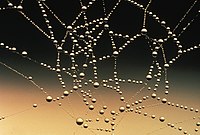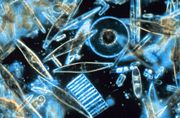| Human uses
For drinking
About 70% of the fat free mass of the human body is made of water. To function properly, the body requires between one and seven liters of water per day to avoid dehydration; the precise amount depends on the level of activity, temperature, humidity, and other factors. Most of this is ingested through foods or beverages other than drinking straight water. It is not clear how much water intake is needed by healthy people, though most experts agree that 8-10 glasses of water (approximately 2 liters) daily is the minimum to maintain proper hydration. For those who do not have kidney problems, it is rather difficult to drink too much water, but (especially in warm humid weather and while exercising) it is dangerous to drink too little. People can drink far more water than necessary while exercising, however, putting them at risk of water intoxication, which can be fatal. The "fact" that a person should consume eight glasses of water per day cannot be traced back to a scientific source. There are other myths such as the effect of water on weight loss and constipation that have been dispelled.
Original recommendation for water intake in 1945 by the Food and Nutrition Board of the National Research Council read: "An ordinary standard for diverse persons is 1 milliliter for each calorie of food. Most of this quantity is contained in prepared foods." The latest dietary reference intake report by the United States National Research Council in general recommended (including food sources): 2.7 liters of water total for women and 3.7 liters for men. Also noted is that normally, about 20 percent of water intake comes from food, while the rest comes from drinking water and beverages (caffeinated included).
Water is excreted from the body in multiple forms; through urine and feces, through sweating, and by exhalation of water vapor in the breath. With physical exertion and heat exposure, water loss will increase and daily fluid needs may increase as well. Humans require water that does not contain too many impurities. Common impurities include metal salts and/or harmful bacteria, such as Vibrio. Some solutes are acceptable and even desirable for taste enhancement and to provide needed electrolytes. The single largest freshwater resource suitable for drinking is the Lake Baikal in Siberia, which has a very low salt and calcium content and is very clean.
As a solvent
Dissolving (or suspending) is used to wash everyday items such as the human body, clothes, floors, cars, food, and pets. Sometimes water is not enough, and many chemicals can be added in order to improve the solvating power of water. These chemicals include saliva, soap, shampoo, alcohol, vinegar and various surfactants; these are all examples of emulsifying agents. When water will not do (to remove a non-water-soluble substance such as paint), other solvents are used, such as ethanol (in meths) or acetone (in nail varnish remover).
As a thermal transfer agent
Boiling, steaming, and simmering are popular cooking methods that often require immersing food in water or its gaseous state, steam. Water is also used in industrial contexts as a coolant, and in almost all power-stations as a coolant and to drive steam turbines to generate electricity. In the nuclear industry, water can also be used as a neutron moderator.
Recreation
Humans use water for many recreational purposes, as well as for exercising and for sports. Some of these include swimming, waterskiing, boating, fishing, and diving. In addition, some sports, like ice hockey and ice skating, are played on ice.
Lakesides and beaches are popular places for people to go to relax and enjoy recreation. Many find the sound of flowing water to be calming, too. Some keep fish and other life in water tanks or ponds for show, fun, and companionship. People may also use water for play fighting such as with snowballs, water guns or water balloons.
Industrial applications
Pressurized water is used in water blasting and water jet cutters. Also, very high pressure water guns are used for precise cutting. It works very well, is relatively safe, and is not harmful to the environment.
Food Processing
Water plays many critical roles within the field of food science. It is important for a food scientist to understand the roles that water plays within food processing to ensure the success of their products.
Solutes such as salts and sugars found in water affect the physical properties of water. The boiling and freezing points of water is affected by solutes. One mole of sucrose (sugar) raises the boiling point of water by 0.52 °C, and one mole of salt raises the boiling point by 1.04 degrees while lowering the freezing point of water in a similar way. Solutes in water also affect water activity which affects many chemical reactions and the growth of microbes in food. Water activity can be described as a ratio of the vapor pressure of water in a solution to the vapor pressure of pure water. Solutes in water lower water activity. This is important to know because most bacterial growth ceases at low levels of water activity. Not only does microbial growth affect the safety of food but also the preservation and shelf life of food.
Water hardness is also a critical factor in food processing. It can dramatically affect the quality of a product as well as playing a role in sanitation. Water hardness is classified based on the amounts of removable calcium carbonate salt it contains per gallon. Water hardness is measured in grains; 0.064 g calcium carbonate is equivalent to one grain of hardness. Water is classified as soft if it contains 1 to 4 grains, medium if it contains 5 to 10 grains and hard if it contains 11 to 20 grains. The hardness of water may be altered or treated by using a chemical ion exchange system. The hardness of water also affects its pH balance which plays a critical role in food processing. For example, hard water prevents successful production of clear beverages. Water hardness also affects sanitation; with increasing hardness, there is a loss of effectiveness for its use as a sanitizer.
Power Generation
Hydroelectricity is electricity obtained from hydropower. Hydroelectric power comes from water driving a water turbine connected to a generator. Hydroelectricity is a low-cost, non-polluting, renewable energy source. |







